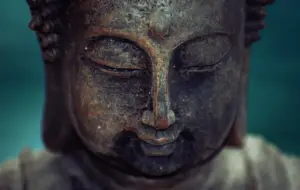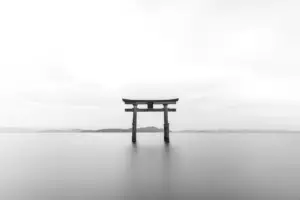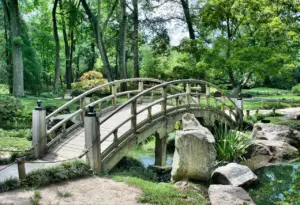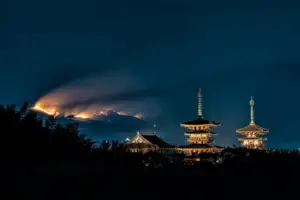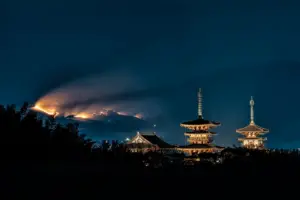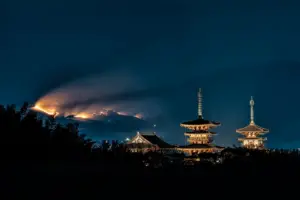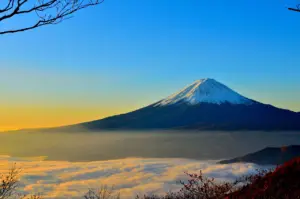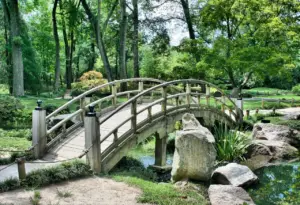As you enter the serene world of Zen Buddhism, you may find yourself drawn to the practice of tea ceremony. This ancient ritual has been a cornerstone of Japanese culture for centuries, and it holds a special place in the hearts of Zen practitioners.
Through the art of tea, you can experience a profound sense of calm and connection to the present moment, as well as a deep appreciation for the beauty of simplicity.
The significance of tea ceremony in Zen Buddhism goes far beyond the mere act of drinking tea. It is a practice that embodies the very essence of Zen philosophy, with its emphasis on mindfulness, harmony, and respect for nature.
By engaging in this ritual, you can develop a greater sense of awareness and presence, as well as a deeper understanding of the interconnectedness of all things. So if you are seeking a path to inner peace and enlightenment, the art of tea ceremony may hold the key you have been searching for.
Key Takeaways
- Tea ceremony is a cornerstone of Japanese culture and embodies the essence of Zen philosophy.
- The key principles of tea ceremony include harmony, respect, tranquility, and simplicity.
- The tea ceremony can have benefits for mental health and well-being, promoting a sense of calm and mindfulness.
- Adapting the tea ceremony to different cultures and contexts has helped spread the practice of Zen Buddhism worldwide, becoming a symbol of mindfulness and meditation.
History and Origins of Tea Ceremony in Japan
You can imagine yourself in ancient Japan, sitting on a tatami mat, as you learn about the history and origins of the tea ceremony.
It all began in the 9th century when the Buddhist monk, Eichu, brought back tea seeds from China. However, it wasn’t until the 12th century when the monk, Eisai, wrote a book called ‘Kissa Yojoki’ (Book of Tea), that the tea ceremony began to take shape. Eisai believed that tea had medicinal properties and could aid in the practice of Zen Buddhism.
During the 16th century, the tea ceremony was further refined by the tea master, Sen no Rikyu. He believed that the tea ceremony should be a simple yet profound experience, where the focus was on the present moment and the interaction between the host and guest.
Rikyu’s teachings and philosophy became the foundation of the tea ceremony as we know it today, and it has become an integral part of Japanese culture and Zen Buddhism.
The Philosophy and Principles of Tea Ceremony
Now, let’s talk about what makes the philosophy and principles of this ancient tradition so captivating.
The tea ceremony, or Chanoyu, isn’t just about preparing and serving tea. It’s an art form, a way of life, and a spiritual practice that embodies the essence of Zen Buddhism.
Here are some of the key principles and philosophies that make this practice so profound:
-
Harmony: The tea ceremony emphasizes the importance of harmony or Wa, which refers to the unity and balance between all elements of the ceremony, including the host, guests, tea utensils, and environment. This principle also extends to the relationship between humans and nature, and the need for humans to live in harmony with the natural world.
-
Respect: The tea ceremony cultivates a deep sense of respect or Kei towards oneself, others, and the objects used in the ceremony. This includes bowing to each other, handling the utensils with care, and appreciating the beauty and significance of each object.
-
Tranquility: The tea ceremony is a meditative practice that encourages a calm and tranquil state of mind. The simple act of making and serving tea can help one achieve a sense of inner peace and mindfulness.
-
Simplicity: The tea ceremony emphasizes the beauty and simplicity of everyday life. It encourages us to appreciate the small things and find joy in the present moment, rather than constantly striving for material possessions or external achievements.
The Role of Tea Ceremony in Zen Buddhism
Discovering the role of tea ceremony in Zen Buddhism can provide a deeper understanding of its spiritual significance. In Zen Buddhism, the tea ceremony is not just a cultural tradition or a simple social gathering, but a spiritual practice that embodies the principles of mindfulness, simplicity, and harmony. Through the process of preparing and serving tea, participants aim to cultivate a state of inner peace, stillness, and awareness, which are essential qualities for achieving enlightenment.
The tea ceremony is also a way of expressing gratitude and respect towards nature, life, and all sentient beings. This is reflected in the way tea is prepared, served, and consumed, which involves a deep appreciation of the beauty and fragility of existence. As the tea master pours tea into the cups, he or she is not just pouring a liquid, but offering a gift of love, compassion, and wisdom. This act of sharing tea is a symbol of the interconnectedness and interdependence of all things, and a reminder that we are all part of the universal flow of life.
| Column 1 | Column 2 |
|---|---|
| Mindfulness | The tea ceremony is a way of cultivating mindfulness by focusing on the present moment and being fully aware of the sensory experience. |
| Simplicity | The tea ceremony emphasizes simplicity by using minimalistic utensils and decorations, and avoiding unnecessary distractions. |
| Harmony | The tea ceremony promotes harmony by creating a peaceful and respectful atmosphere, and fostering a sense of unity and interconnectedness among participants. |
In essence, the tea ceremony in Zen Buddhism is a transformative practice that helps individuals connect with their inner selves, with others, and with the natural world. By embracing the philosophy and principles of tea ceremony, one can develop a deeper sense of compassion, gratitude, and wisdom, which are essential qualities for leading a fulfilling and meaningful life.
The Rituals and Procedures of Tea Ceremony
Immerse yourself in the rituals and procedures of the tea ceremony, and you’ll find yourself transported to a world beyond the mundane. Every movement and gesture is imbued with profound meaning and symbolism, creating an atmosphere of serenity and contemplation. The tea ceremony isn’t just about drinking tea, but it’s a spiritual practice that requires the utmost attention and respect.
The rituals and procedures of the tea ceremony are intricate and precise, with every detail carefully planned and executed. Here are some of the essential components of the tea ceremony:
-
Preparation: The host meticulously prepares the tea room and all the utensils, ensuring that everything is clean and ready for the ceremony.
-
Cleansing: Before entering the tea room, guests must purify themselves by washing their hands and mouths, symbolizing the shedding of worldly distractions and entering a state of mindfulness.
-
Serving: The host prepares the tea with utmost care and serves it to the guests, who receive it with gratitude and respect.
-
Appreciation: The guests carefully observe and appreciate the tea, the utensils, and the surroundings, taking in every detail and expressing their gratitude to the host.
The tea ceremony is a beautiful and profound practice that can help us cultivate mindfulness, gratitude, and respect for ourselves, others, and the world around us.
The Experience of Tea Ceremony
As you experience the tea ceremony, you’ll be immersed in a world of sensory and emotional elements. The aroma of the tea, the sound of the water boiling, the beauty of the tea utensils, and the warmth of the cup in your hands will all contribute to a serene atmosphere.
This experience can have benefits for your mental health and well-being, helping you to relax and find inner peace. As you continue to practice the tea ceremony, you may also experience personal growth and spiritual development. This can lead to a deeper understanding of yourself and the world around you.
Sensory and Emotional Elements
With its delicate aromas and serene atmosphere, the tea ceremony in Zen Buddhism combines sensory and emotional elements to create a truly meditative experience. The ceremony is a sensory feast that engages all your senses, from the sound of the water boiling to the feel of the warm cup in your hands. As you sip the tea, you are transported to a different state of mind, one where you can let go of your worries and be in the present moment.
The tea ceremony is also an emotional experience that encourages you to connect with your feelings. As you sit in silence, you can reflect on your thoughts and emotions without judgment. This introspection allows you to cultivate a sense of mindfulness and awareness of your inner world. The table below summarizes the sensory and emotional elements of the tea ceremony:
| Sensory Elements | Emotional Elements |
|---|---|
| Aromas of tea | Reflection |
| Sound of water | Mindfulness |
| Feel of the cup | Awareness |
| Taste of tea | Serenity |
| Serene atmosphere | Connection |
Take a moment to reflect on the sensory and emotional elements of the tea ceremony. How do they make you feel? Can you incorporate some of these elements into your daily life to cultivate a sense of mindfulness and awareness? The tea ceremony in Zen Buddhism is a beautiful reminder of the importance of slowing down and being present in the moment.
Benefits for Mental Health and Well-being
Indulging in the meditative experience of tea can have a profound impact on your mental health, providing a sense of calm and mindfulness in a hectic world. The tea ceremony is a ritual that encourages you to slow down and appreciate the present moment. It invites you to savor the aroma, taste, and texture of the tea, and to be fully present in the company of others.
Incorporating tea into your daily routine can bring about numerous benefits for your mental health and well-being. Here are a few ways in which the tea ceremony can help you feel more centered and grounded:
- Tea can help you relax and reduce stress
- It can improve your focus and concentration
- The ritual of the tea ceremony can foster a sense of community and connection with others.
By taking the time to enjoy a cup of tea mindfully, you can cultivate a greater sense of peace and balance in your life.
Personal Growth and Spiritual Development
Immersing oneself in the meditative experience of a tea ritual can lead to a deeper understanding of oneself and the world around them. Through the practice of tea ceremony, one learns to be fully present in the moment, to focus on each movement and gesture with mindfulness and intention. This level of awareness can carry over into other areas of life, allowing for a greater sense of connection and purpose.
Tea ceremony also encourages personal growth and spiritual development. By honing one’s skills and knowledge of the ceremony, one can cultivate a sense of discipline, humility, and respect for others. The ceremony can also serve as a means of self-reflection, allowing for a deeper exploration of one’s own thoughts and emotions.
Ultimately, the tea ceremony in Zen Buddhism is not just a ritual, but a way of life that can lead to greater peace, harmony, and understanding.
Tea Ceremony in the Modern World
As you delve into the world of tea ceremony in the modern era, you’ll encounter a diverse landscape shaped by globalization and adaptation.
This art form has undergone significant changes to preserve its essence while also reviving its spirit.
Despite the challenges, tea ceremony has found a way to seamlessly integrate with contemporary lifestyles. It has become a mindful practice that can be enjoyed by people from all walks of life.
Globalization and Adaptation
Adapting the tea ceremony to different cultures and contexts has helped spread the practice of zen Buddhism worldwide. Through globalization, the tea ceremony has become a symbol of mindfulness and meditation. It has been embraced by people from all walks of life, who seek a moment of peace and tranquility in their busy lives.
The tea ceremony has also evolved to suit the modern world, with new variations and adaptations being created to cater to different lifestyles and needs. Here are three ways in which the tea ceremony has been adapted:
-
Tea-to-go: With the rise of mobile lifestyles, tea ceremonies have been adapted to be portable, allowing people to take their tea ceremony with them wherever they go.
-
Virtual tea ceremonies: In the age of technology, virtual tea ceremonies have been created, allowing people to connect with others from around the world and participate in a shared experience.
-
Tea and wellness retreats: The tea ceremony has been incorporated into wellness retreats, where participants can enjoy the benefits of mindfulness and meditation, while also learning about the art of tea-making.
In this way, the tea ceremony continues to be a powerful tool for spreading the teachings of zen Buddhism, while adapting to the needs of the modern world.
Preservation and Revival
Nowadays, there’s a renewed interest in the traditional art of tea-making, with many individuals and organizations working to preserve and revive this ancient practice.
The tea ceremony, also known as Chanoyu or Sado, is a key component of Zen Buddhism, and it’s been practiced for centuries in Japan. This ritual involves the preparation and serving of matcha, a powdered green tea, in a serene and contemplative setting.
The tea ceremony is more than just a simple act of making tea; it’s a spiritual practice that emphasizes mindfulness, harmony, and simplicity.
The revival of tea ceremony is not just a nostalgic trend; it’s a response to the fast-paced, technology-driven modern world. In a world where everything is instant and automated, the tea ceremony offers a respite from the chaos and noise of daily life.
By participating in the tea ceremony, one can slow down, focus on the present moment, and appreciate the beauty of simplicity. In this way, the tea ceremony is not just a cultural practice; it’s a way of life that can help us reconnect with ourselves and with nature.
Integration with Contemporary Lifestyles
You can easily integrate the practice of making and enjoying tea into your contemporary lifestyle, allowing you to slow down and appreciate the present moment amidst the fast-paced world around you. The tea ceremony in Zen Buddhism is not just a ritual, but a way of life that emphasizes mindfulness, simplicity, and harmony with nature. By incorporating these values into your daily routine, you can cultivate a sense of peace and tranquility that will help you navigate the stresses and challenges of modern life.
To help you get started, here is a simple three-step process for making tea in the traditional Japanese style:
| Step | Instructions |
|---|---|
| 1 | Rinse the teapot and cups with hot water. |
| 2 | Add loose leaf tea to the teapot and pour hot water over it. Let it steep for a few minutes. |
| 3 | Pour the tea into the cups and enjoy. |
Remember, the goal is not just to make a cup of tea, but to savor the experience and appreciate the beauty and simplicity of the process. Take your time, breathe deeply, and allow yourself to be fully present in the moment. As you do so, you may find that the tea ceremony becomes a powerful tool for cultivating mindfulness, serenity, and inner peace.
Tea Ceremony and Cultural Exchange
Through the practice of tea ceremony, Zen Buddhism has fostered cultural exchange and appreciation for centuries. The tea ceremony, also known as Cha-no-yu or Sado, involves the preparation and serving of tea in a ritualistic manner.
This ceremony is not only a way to enjoy a cup of tea but also a way to cultivate mindfulness, gratitude, and hospitality. The tea ceremony has been practiced not only in Japan but also in other countries, including China, Korea, and Taiwan.
This has led to a cultural exchange where people from different backgrounds can come together and appreciate the beauty and simplicity of the tea ceremony. Through this exchange, we can learn about different cultures and traditions, and find common ground in our shared love for tea.
The tea ceremony reminds us to slow down, be present in the moment, and appreciate the simple things in life.
Frequently Asked Questions
What are the health benefits of drinking tea during a tea ceremony?
As you sip on your cup of tea during the tea ceremony, you may feel a sense of calm and tranquility wash over you.
Not only does tea contain antioxidants and other health benefits, but the act of taking a few moments to pause and appreciate the present moment can also have a positive impact on your well-being.
The warmth of the tea and the ritual of preparing and serving it can bring a sense of grounding and mindfulness to your day.
So take a deep breath, savor the taste of the tea, and allow yourself to be fully present in this moment.
What is the significance of the specific ceremony utensils used in a tea ceremony?
As you sit in the peaceful setting of a tea ceremony, you may notice the intricate and unique utensils used to prepare and serve the tea. These utensils hold great significance in the ceremony, as they are carefully chosen and crafted to enhance the experience of the tea and create a sense of harmony and balance.
The teapot, for example, symbolizes the heart, while the tea scoop represents the mind. Each utensil is used with precision and intention, allowing for a deeper connection with the tea and the present moment.
As you partake in the ceremony, allow yourself to be fully immersed in its beauty and meaning, and appreciate the importance of each utensil in creating a truly transformative experience.
How has the tea ceremony evolved over time in different regions of Japan?
As you delve into the history of the tea ceremony, you’ll find that it has evolved and taken on unique characteristics in different regions of Japan.
Each region has its own distinct style and approach to the ceremony, influenced by its culture, climate, and traditions.
For example, the Uji region in Kyoto is known for its focus on the tea’s flavor and aroma, while the Sencha tea ceremony of the Shizuoka region emphasizes the beauty of the tea leaves and the natural surroundings.
These variations in the tea ceremony reflect the diversity of Japan’s culture and the importance placed on mindfulness, respect, and simplicity in everyday life.
At its core, the tea ceremony remains a practice of Zen Buddhism, promoting inner peace and spiritual growth through the simple act of sharing tea with others.
Is the tea used in a tea ceremony different from regular tea?
When you sit down for a traditional tea ceremony, you may notice that the tea being served looks and tastes different from what you’re used to. That’s because the tea used in a tea ceremony is often a high-quality, powdered green tea known as matcha.
This special tea is made from shade-grown tea leaves that are ground into a fine powder, giving it a unique flavor and texture. But the difference goes beyond just the tea itself.
The tea ceremony is a time-honored tradition that emphasizes mindfulness, simplicity, and respect for others. It’s a way to slow down and appreciate the beauty of the present moment, and the tea itself is just one small part of that experience.
So while the tea used in a tea ceremony is certainly different from what you might drink on a daily basis, it’s really just a symbol of the deeper values and principles that underpin this ancient practice.
What impact has the tea ceremony had on Japanese culture beyond Zen Buddhism?
As you ponder the impact of the tea ceremony on Japanese culture, you can’t help but be struck by the profound influence it’s had.
The tea ceremony isn’t just a practice of Zen Buddhism but a cultural phenomenon that’s shaped Japanese society in many ways.
The simple act of making tea has become an art form, a way of life, and a symbol of Japanese aesthetics and hospitality.
From the traditional tea houses to modern tea shops, tea has become an integral part of Japanese culture.
The ceremony’s emphasis on mindfulness, respect, and harmony has also influenced other aspects of Japanese life, from calligraphy to flower arrangement.
In short, the tea ceremony has helped shape the very essence of Japanese identity, and its impact will continue to be felt for generations to come.
Conclusion
As you conclude your exploration of the significance of tea ceremony in Zen Buddhism, take a moment to reflect on the beauty and simplicity of this ancient practice. The tea ceremony isn’t just a ritual, but a way of life, rooted in the principles of harmony, respect, purity, and tranquility.
It’s a reminder to slow down, savor the moment, and appreciate the beauty in the ordinary. Through the tea ceremony, you’ve gained a deeper understanding of Japanese culture and the Zen Buddhist philosophy.
You’ve witnessed the power of mindfulness, concentration, and meditation, as well as the importance of community and connection. May this knowledge inspire you to live your life with intention and purpose, and to appreciate the simple pleasures that bring us all together.











